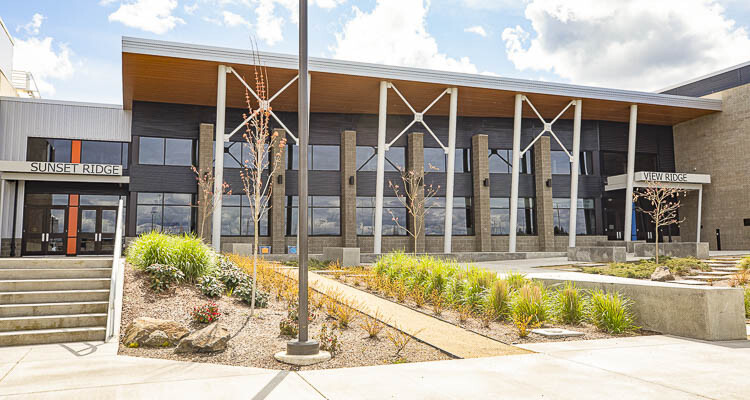
Ridgefield resident Heidi Pozzo believes the Ridgefield School District Board of Directors made a series of decisions that impacted the capacity of the schools at a time when it was needed most
Heidi Pozzo
for Clark County Today
“How did we get here?” That was the question in a Ridgefield School District capital facility needs presentation at the School Board meeting on Nov. 28, 2023. The implication being that voters were to blame for not passing bond measures to increase needed capacity. Clearly when a bond doesn’t pass, that means funds aren’t available to build more schools. But is that the whole story?

As it turns out, the board made a series of decisions that impacted the capacity of the schools at a time when it was needed most.
By making the decision to take $15.5 million in estimated state funds to build the new middle/intermediate school, the district agreed that it would no longer use the old View Ridge Middle School for K-12 purposes. That means that capacity for 400+ students, between permanent and portable classrooms per the 2015 Capital Facility Plan, was eliminated.
At a time of known capacity shortage, a trade off analysis between taking $15.5 million in state funds and eliminating capacity or forgoing the funds and keeping the capacity in place would lead to one answer. Keep the capacity because it is more expensive to build a new school. But the Board chose not to. And while the District ultimately received $3.3 million more in state funds, the analysis would still result in the same answer.
During the same period, the district and the city of Ridgefield worked collaboratively to develop the Ridgefield Outdoor Recreation Center (RORC), including the placement of the facility. The District provided a roughly 30 acre parcel of land that the RORC sits on.
The RORC was placed on the prime portions of land, while the new middle/intermediate school were placed between two wetland areas. Through this exercise, a portion of the school and parking areas were placed on land owned by the city. As a result, the city and the district swapped parcels of land.
Because of the placement of the building between two wetlands and the construction of the RORC on the district owned land, the ability to procure and place portables to accommodate enrollment growth was precluded.
Further complicating the situation is the design of the 148,932 sq. ft. middle/intermediate school itself. The district designed the 43 teaching station school with dedicated spaces for activities such as the wrestling room and the performing arts black box theater. As a result, the use of those activity spaces as classrooms has garnered criticism.
The district’s plan for middle/intermediate growth at the time was to build another similar school for 1,000-plus students. So, with no flex capacity at the old school, dedicated spaces that are not easily converted to class space at the new school and no ability to add portable capacity at the new school, the District left as its only option building a new school for a capacity of 1,000-plus..
From a strategic perspective, it is unusual to have as the only option the need to double capacity through building a new school.
There was a plan in 2012 to build a new high school on the 50 acre parcel occupied by the RORC and View Ridge/Sunset Ridge and convert the high school into a middle school. That would have provided significantly more flexible capacity at a lower cost as well. That plan was scrapped for what we have today.
Yes, there is an impact from new bonds not being voted through. The District has also contributed to the problem by its decisions and not providing a stair step approach to addressing capacity issues.
Heidi Pozzo has been a Ridgefield resident for 16 years. She is a concerned citizen who would like students to get a good education and thinks we can do it in a more cost-effective way.
Also read:
- Letter: ‘Something is wrong when our vote means nothing’Bob Zak challenges the political handling of the I-5 Bridge project and urges voters to demand accountability.
- Letter: ‘This is a time for bold leadership, clear advocacy, and strong representation’Justin Forsman of Vancouver announces his candidacy for mayor and outlines a bold new platform focused on rights, infrastructure, and local governance.
- Opinion: Schools notifying parents about the kinds of care kids can decide on their own didn’t make itElizabeth New criticizes the removal of Amendment 1164 from current legislation, arguing it leaves parents uninformed about health care services accessed by their children through schools.
- Opinion: Off-road vehicles in the neighborhoodDoug Dahl responds to a resident’s concern about off-road vehicles on neighborhood streets, outlining the legal violations and safety risks involved.
- POLL: Is America more united or more divided than it was a decade ago?Clark County Today’s weekly poll asks: Is America more united or more divided today? The question comes after Stephen Davis brought a powerful message to Vancouver.











Adding classrooms should be the top priority for a new Elementary school. With $18 million in impact fees that CAN be used for the elementary school. (Verified by school officials). The school district decided against it. So instead of $36m bond, we repeat history and run up the credit expense of Ridgefield residents property taxes.
My vote will be NO, because we can build schools and be fiscally responsible.
Impact fees were applied to the upcoming Bond Measures Proposition 10 and 11, in fact 10 million of the 18 you referenced were applied. This decision was made based on feedback from Ms. Pozzo and our community. Please see the attached FAQ that explains in detail. Unfortunately, the more we delay and pontificate on how schools can be built for less, or youngest community members are feeling the impacts of our decisions. Bonding is how schools are built in Washington, we can’t delay any longer we our students need a solution now. You can read the full district FAQ’s here.
Great article and analysis, Heidi.
RSD chose to repeatedly ignore voters and think they could pull it out no matter the next time. Each time it’s failed. The solution was going back and saying, “We hear you” and coming up with a more sensible plan. But now they’ve come up with this “bond-doggle” by putting a terrible OR a really really really terrible bond choice hoping that voters will be duped into the lesser of two evils which will be the biggest bond approval ever of $70M (probably without interest so way more with today’s rates). VOTE NO… we can’t reward their bad behavior.
The impact fees are only being applied to Proposition 2, not for Proposition 1. So I think you missed my point. I also made this point before the propositions were voted on by the board. The immediate need is for an elementary school, the rest of the list are wants.
The elementary school will only be filled 1/2 of it’s capacity. So likely it will be for K-6 to offset the middle & intermediate school.
Some stats you won’t find on any FAQ.
K-4 Existing capacity 1225 Enrollment: 1481 6 Portables will hold that, we have 19 portables for the Elementary.
5-8 Existing Capacity 1200 Enrollment: 1296 2 Portables will hold that, we have 4 for the Intermediate and Middle School
Each year, the school district gets $9m in impact fees from the growth. They will easily replenish the capital funds for future planning.
So the answer is NO, they aren’t using the $18m in impact fees for the Elementary School.
To say bonding is the way schools are built is not exactly true- it is ONE way schools are built. Schools can be privately funded and have been built using raised funds. It is as if there are people in our community, I guess, who have no issue paying more taxes when some of us are literally taxed to the limit. There are other solutions then a bond. In addition, there are a great number of children being pulled from public school for a whole host of reasons. So as Star pointed out, portables would work just fine. And if funds are raised for a new school, how about some common sense on the building materials? The last school built had all the new shiny expensive pieces that most likely could have been done more fiscally sound. Just ideas..
Very well written letter, Heidi. As the other commenter said, the vote for the bond will continue to be no. I have never ever understood the argument against portables. Personally have had many classes in them and the curriculum was taught just fine. Of course, there are politics behind all the decisions Heidi laid out and certainly a pro-bond commenter will emerge. When there were other options that would have provided the class space (and no issue with theater and wrestling space. Arts and sports are important), the powers that be made a poor choice.
Not to mention the mismanagement of using impact fees for breaking ground on construction dependent on the last bond attempt.